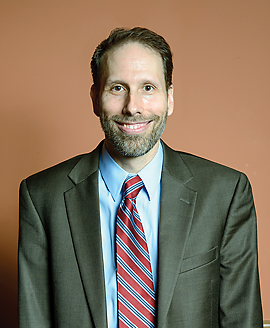Higher-quality, lower-cost care—as promised by the vision of integrated, collaborative care—is going to be politically disruptive. But it’s disruption that is bound to come—that has to come—as America’s health care system, in the absence of transformative change, wobbles toward a collapse.
That’s the message that primary care physician Jeffrey Brenner, M.D., delivered to psychiatrists at APA’s Institute on Psychiatric Services (IPS) in Philadelphia in October.
At the IPS, Brenner emphasized that providing better but cheaper care will disrupt a hospital industry built on offering high-tech “sickness” care and a payment system geared to rewarding tests and procedures rather than “cognitive” services and talking to patients. But he said that it is a disruption that is bound to come, and without it, catastrophe could ensue.
He likened that catastrophe to the 2008 housing and financial industries collapse. “A health care system that is 18 percent of the economy doesn’t change and tip over nicely,” he said. “Put this in perspective: health care is 18 percent of the economy, housing is 11 percent of the economy, and finance is 7 percent of the economy. Look at what happened when 11 percent and 7 percent of the economy blew up. Imagine what is going to happen when 18 percent of the economy blows up, when the underpinnings of health care don’t work anymore.”
Few Patients Account for Substantial Costs
Brenner is the founder of Camden Coalition of Healthcare Providers and a pioneer in helping create health care delivery models to meet the needs of the most vulnerable citizens in impoverished communities. Determined to improve the lives of the sickest residents of Camden, N.J.—one of America’s poorest cities—Brenner constructed a searchable database and geographic mapping of discharge data from all patients at Camden’s hospitals and discovered locally what is true throughout the United States: that a very small number of patients consumed a large share of the overall costs of health care and social supports.
And these high utilizers, some of whom may have dozens of visits to the emergency department in a year, are also typically receiving the worst care: unnecessary, duplicative tests, scans, or procedures that overlook their most pressing needs.
Brenner set about creating a highly structured community outreach program—similar to the Assertive Community Treatment teams developed by psychiatrist Leonard Stein, M.D., and colleagues—to meet with Camden’s high utilizers and work intensively to help them to achieve better health, while making better, more efficient, less costly use of services.
He has vowed to make poverty- and trouble-ridden Camden the first community in America to “bend the cost curve.” And his work, which has come to be known as health care “hot spotting” recently garnered him a MacArthur Genius Award. In the January 24, 2011, New Yorker, physician-author Atul Gawande, M.D., featured Brenner in an article titled, “The Hot Spotters.”
“The Camden Coalition has been able to measure its long-term effect on its first 36 super-utilizers,” Gawande wrote. “They averaged 62 hospital and E.R. visits per month before joining the program and 37 visits after—a 40 percent reduction. Their hospital bills averaged $1.2 million per month before and just over half a million after—a 56 percent reduction…. Brenner and his team are out there on the boulevards of Camden demonstrating the possibilities of a strange new approach to health care: to look for the most expensive patients in the system and then direct resources and brainpower toward helping them.”
Health System Change Needs Psychiatry
At the IPS meeting, Brenner described how he made block-by-block maps of Camden, color-coded by the hospital costs for its residents, and then looked for the hot spots. What he found was startling: in a six-year period, some 900 people in two low-income buildings accounted for more than 4,000 hospital visits and about $200 million in health care bills.
“Hot spotting is really about finding outliers in data sets,” Brenner said. And he said similar data are available to physicians anywhere in any community.
He described one patient who, in a short time span, was found to have had 102 emergency room visits, 54 hospital admissions, and 147 CAT scans, including 73 CAT scans of the head—all of them normal, and enough radiation, Brenner said, to increase her lifetime risk for cancer. When the community outreach team—including a psychologist embedded in the family practice—began to work intensively with her, it was discovered that she had an anxiety disorder.
“She basically wanted someone to pay attention to her,” he said. “Over time as the team worked with her, she stopped going [to the hospital].”
Brenner said cases like this illustrate that the transformation of American health necessary to avert financial collapse cannot happen without the help of psychiatry and behavioral health. He cited the Adverse Childhood Experience (ACE) study, a collaboration of the Centers for Disease Control and Kaiser Permanente’s Health Appraisal Clinic in San Diego, which was akin to an early “hot spotting” study. Data were collected on more than 17,000 individuals between 1995 and 1997 showing that early childhood trauma—abuse, neglect, divorce, family violence and other factors—was highly correlated with later high utilization of medical services.
He urged psychiatrists to undertake their own hot spotting initiatives in their communities. Don’t wait for funding and don’t ask for permission, he said, just do it, and the health systems that are increasingly being held accountable for quality and cost will recognize you.
“We know in America our demographic bubble is going to break,” he said. “We have 85 million baby boomers headed like a freight train for the most expensive health care system in the world. I suggest that you go out and build the most interesting and innovative program possible for five or 10 or 15 people. I know behavioral health is banging on the door saying, ‘don’t forget us.’ But stop banging on the door. Work on building your own programs, get the costs of your interventions down, and [health systems] will come to you. ■

